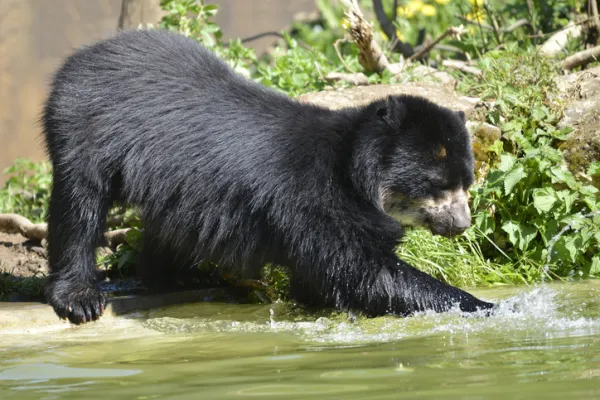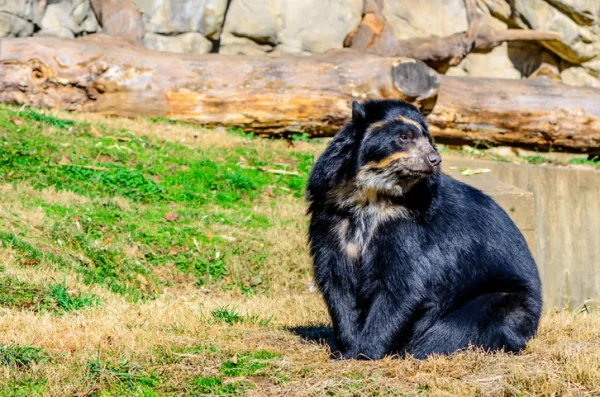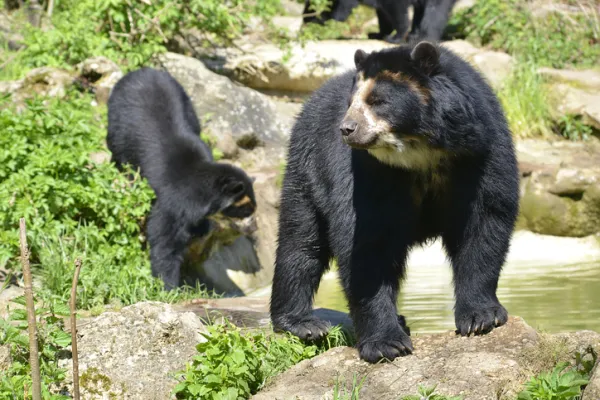The spectacled bear—also called the Andean bear or South American bear—is one of the world’s eight living bear species and the only bear native to South America. Today, an estimated ~18,000 individuals survive in the wild across the Andes, yet rapid environmental change and human pressures are pushing the species toward an uncertain future. Highly dependent on cloud forests, páramo grasslands, and montane shrublands, spectacled bears are vulnerable to habitat loss, fragmented landscapes, declining food resources, and conflict with people.

(Tremarctos ornatus · “Andean bear” / “South American bear”)
IUCN Red List: Vulnerable (VU) overall; regionally Endangered in parts of its range.
Main threats: habitat loss/fragmentation (logging, roads, agriculture), urban and agricultural expansion, climate change impacts on key foods, and human–bear conflict.
Ecological role: largely plant-based omnivore and an important seed disperser, helping maintain Andean forest diversity and structure.
Why the spectacled bear is endangered (core causes)
Species profile & identification
Habitat & geographic range
Reproduction & behavioral ecology
How to help: conservation measures that work
Key takeaways
FAQs
The IUCN lists the spectacled bear as Vulnerable overall; in some countries/regions, small and fragmented subpopulations meet criteria closer to Endangered.
In Colombia, Peru, Bolivia, Venezuela, and Ecuador, ongoing deforestation and landscape fragmentation reduce and isolate suitable habitat.
Urban growth and agricultural expansion—including roads, bridges, cattle pastures, and monocultures (e.g., cacao)—degrade forests, sever connectivity, and lower reproductive success.
Cloud forests and high-elevation ecosystems are sensitive to shifts in temperature and precipitation.
When the abundance and quality of plant foods (fruits, shoots, palm hearts) decline, bears are more likely to forage near settlements, increasing conflict and retaliatory killing.
Bears that raid crops or approach livestock may be met with traps, poison, or firearms.
With already small subpopulations, even low additional mortality can have outsized, long-term effects.
Bottom line: Habitat change + climate impacts + conflict form a feedback loop that suppresses population recovery.

Scientific name: Tremarctos ornatus
Common names: Spectacled bear, Andean bear; local names include frontino, ucumari, jukumari, among others.
Size: up to ~1.8 m (6 ft) in length; around ~140 kg (300+ lb) for large males (varies by sex, season, and region).
Field marks:
Distinctive pale markings (cream to buff) around the eyes, muzzle, and cheeks, often forming “spectacles.”
Overall dark brown to black coat; robust build; strong climber.
Taxonomy:
Kingdom: Animalia
Phylum: Chordata
Class: Mammalia
Order: Carnivora
Suborder: Caniformia
Superfamily: Arctoidea
Family: Ursidae
Subfamily: Tremarctinae
Genus: Tremarctos
Species: T. ornatus
Diet: Omnivorous with a plant bias—fruits, shoots, tubers, bromeliads, palm hearts; also insects and occasional small vertebrates.
Ecological importance: A key seed disperser and vegetation shaper, maintaining plant diversity and forest regeneration dynamics.
Range: The Andean chain from northern Argentina northward through Bolivia, Peru, Ecuador, and Colombia to western Venezuela.
Habitats: Humid montane forests (cloud forests), páramo grasslands, and some semi-arid montane shrublands.
Altitudinal use: Moves seasonally and with food availability across elevation bands (values vary locally).
Social system: Largely solitary and primarily diurnal.
Communication: Scent marking (pheromones) and tree trunk claw marks signal presence and reproductive status.
Breeding season: Mating typically from March to October; gestation ~6–8 months; litters commonly two cubs.
Winter strategy: Unlike most northern bears, spectacled bears do not typically hibernate. Females prepare a comfortable nest for birth rather than using deep dens.

Goal: stabilize → recover → expand subpopulations while keeping Andean ecosystems connected and functional.
Community-led reforestation & restoration: Local people replant native species in degraded/deforested areas to rebuild food plants and shelter.
Bolivia case study – “Conservation through coexistence: Andean bears and people”:
Outreach with herders and farmers on conflict prevention and alternative livelihoods;
Awareness campaigns to reduce fear and retaliatory responses.
Population monitoring: Camera traps, sign surveys, and genetic sampling to estimate numbers, occupancy, and seasonal movement routes—foundational for reserve design and corridor planning.
Habitat protection and “stitching the patchwork”:
Expand and optimize protected-area networks;
Build ecological corridors that reconnect forest and páramo fragments, mitigate roads/bridges with wildlife crossings.
Conflict mitigation:
Promote non-lethal tools (reinforced apiaries/granaries, guardian dogs, lighting/alarms),
Temporal/spatial adjustments for crops and grazing,
Compensation/insurance schemes to reduce retaliatory killing.
Climate adaptation:
Restore water sources and key food trees (mixed-species plantings, resilient natives),
Safeguard cool-climate refugia and north–south connectivity.
Law and enforcement:
Strengthen local no-hunting regulations,
Enforce against illegal logging and land clearing.
The spectacled bear is South America’s only native bear, assessed as Vulnerable globally; some regional populations verge on Endangered.
ID highlights: pale “spectacles” on a dark face/body; strong climber; mostly solitary and diurnal.
Core threats: habitat loss/fragmentation + climate impacts + human–bear conflict.
Protection levers: habitat connectivity, community co-management, non-lethal conflict tools, and long-term monitoring.
Do spectacled bears mostly eat plants? Will they take livestock?
Yes—diet is predominantly plant-based (fruits, shoots, tubers, palm hearts). Opportunistic livestock depredation is uncommon but can occur, especially with unattended young animals or carcasses. Prevention relies on husbandry and deterrence, not lethal control.
Do spectacled bears hibernate?
Typically no. Females prepare nesting sites for birth rather than deep dens; activity continues through the cool season.
Where do conflicts usually happen, and how can they be reduced?
Most issues arise near crops, orchards, and pastures. Effective tools include secure fencing/enclosures, guardian dogs, temporary deterrents, timing adjustments, and fair compensation.
How can I help directly?
Support reputable NGOs working on reforestation, coexistence, and monitoring; choose no-contact, low-disturbance nature tourism; share evidence-based information and never buy wildlife products.
Saving the spectacled bear means investing in habitat protection, landscape connectivity, community coexistence, and rigorous long-term monitoring. When cloud forests and high-Andean grasslands are healthy and connected, this “spectacled gardener” can keep spreading seeds and sustaining biodiversity across the Andes.
Bibliography
Salazar, Y. (04/09/2017) Bolivian biologist promotes coexistence of Andean bears with people. EFE Agency: Verde - Bolivia Nature.
EFE Editorial: Verde. (01/12/2016) Spectacled bear captured for the first time in the Peruvian Amazon. EFE Agency: Verde - Peru Biodiversity.
EFE Editorial: Verde. (07/23/2014) Ecuador investigates the death of an endangered bear. EFE Agency: Verde - Ecuador Animal Abuse.
animal tags: spectacled bear
We created this article in conjunction with AI technology, then made sure it was fact-checked and edited by a Animals Top editor.